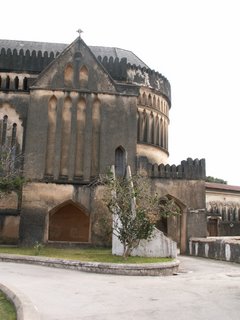Zanzibar Slave Trade

(More to be added to this post later..)
We visited a Christian church built on the site of a former slave market. The chrch's altar was once the location of the whipping post. Zanzibar was once the awful hub of slavers selling people into captivity.

Nearby, at the art gallery where I purchased the tinga tinga paintings, steps in that building led down to a dank basement with low-ceilinged stone rooms hung with chains where
 slaves were kept in horrible crowded conditions before being sold. Up to seventy or so were jammed into a room where twenty could not stand comfortably.
slaves were kept in horrible crowded conditions before being sold. Up to seventy or so were jammed into a room where twenty could not stand comfortably.It was not thought important if some of the captured people died because it was believed that the surviviors would be the fittest and most valuable for sale anyway.
Near the church on a small lawn was a sculture set into the ground to commemorate the memory of the slaves: five human figures carved in stone and chained at the neck.
Following is a very brief history of the ending of the slave trade in Zanzibar, borrowed from a website:
In 1822, the Omani Arabs signed the Moresby treaty which amongst other things, made it illegal for them to sell slaves to Christian powers. So that this agreement could be monitored, the United States and Great Britain established diplomatic relations with Zanzibar, and sent Consuls to the islands. However, the slaving restrictions were largely ignored, and the trade continued to kill and imprison countless Africans.
Caravans started out from Bagamoyo on the mainland coast, travelling as much as 1,000 miles on foot as far as Lake Tanganyika, buying slaves from local rulers on the way, or, more cheaply, simply capturing them. The slaves were chained together and used to carried ivory back to Bagamoyo. The name Bagamoyo means 'lay down your heart;' because it was here that slaves would abandon hope of freedom.

Slaves who survived the long trek from the interior were crammed into dhows bound for Zanzibar, and paraded for sale like cattle in the Slave Market.
All of the main racial groups were involved in the slave trade in some way or other. Europeans used slaves in their plantations in the Indian Ocean islands, Arabs were the main traders, and African rulers sold prisoners taken in battle. Being sold into slavery was not a prisoner's worst fate - if a prolonged conflict led to a glut, the Doe tribe north of Bagamoyo had the rather gruesome habit of eating 'excess supplies'.
Sultan Barghash was forced in 1873, under the threat of a British naval bombardment, to sign an edict which made the sea-borne slave trade illegal, and the slave market in Zanzibar was closed, with the Cathedral Church of Christ erected on the site. But the trade continued, particularly on the mainland. Slaving was illegal, but it existed openly until Britain took over the mainland following their defeat of the Germans in the First World War. Many former slaves found that their conditions had hardly changed - they were now simply employed as labourers at very low wage rates in the spice plantations.


0 Comments:
Post a Comment
<< Home